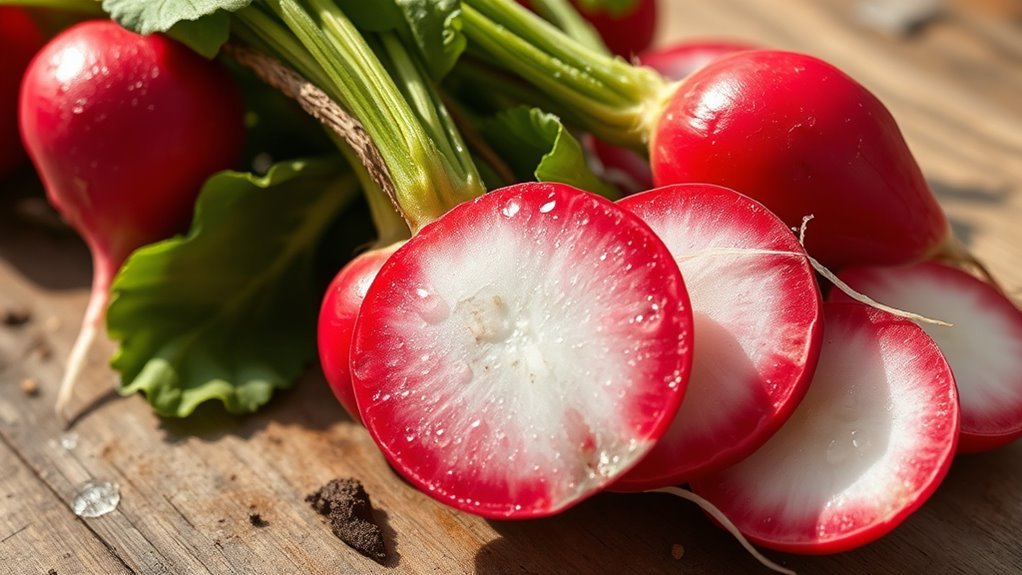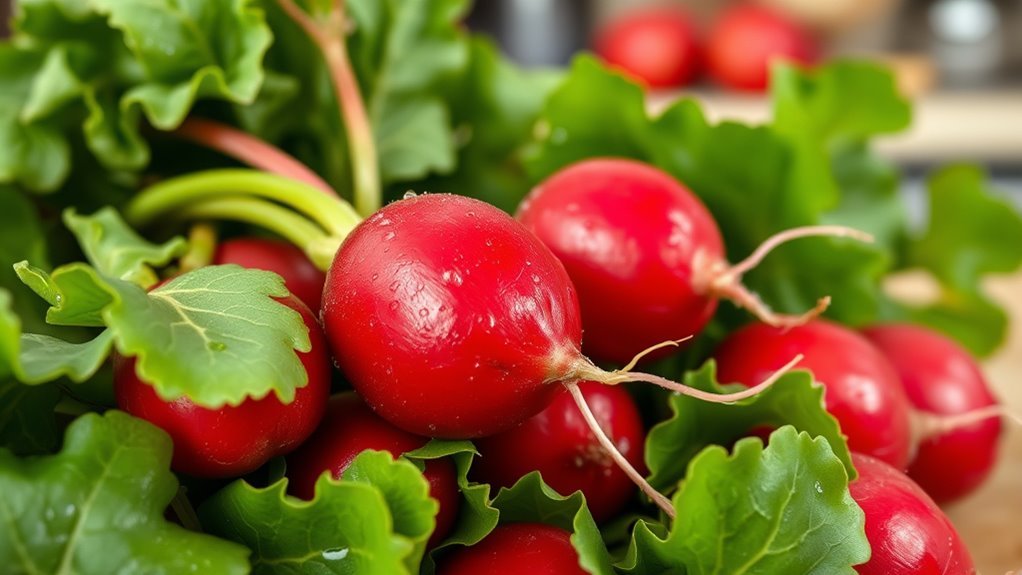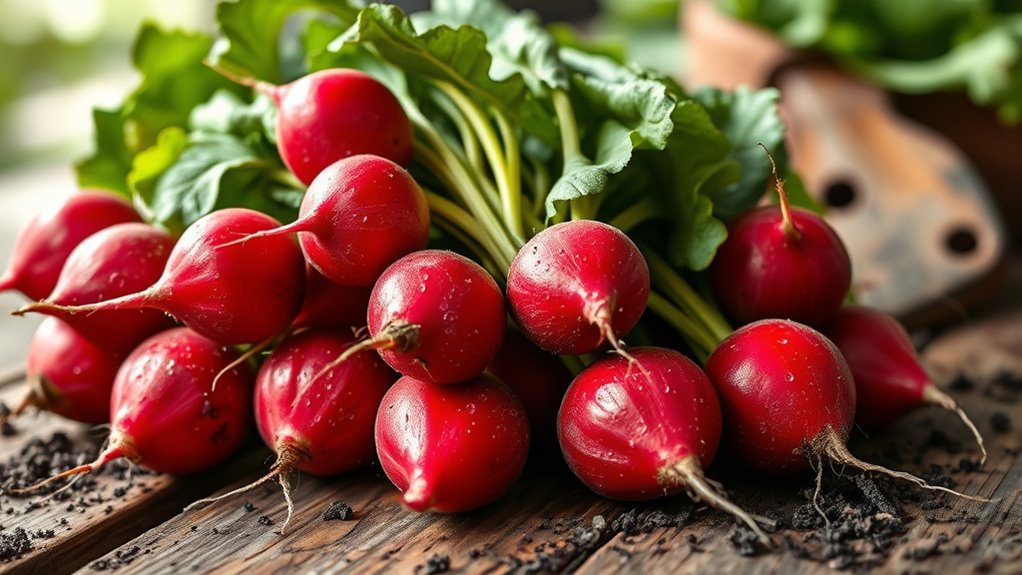Yes, radishes are keto-friendly! With only 1.8 grams of net carbs per 100 grams, they make a great choice for a low-carb diet. Besides their low calorie count, they’re also packed with vitamin C and antioxidants. You can enjoy radishes in various ways, from raw salads to roasted dishes. Just keep in mind any potential side effects if consumed in large quantities. Explore more about how to incorporate radishes into your meals for exciting flavor and crunch!
Nutritional Profile of Radishes

When it comes to the nutritional profile of radishes, these vibrant root vegetables pack a punch. You’ll find a variety of radish varieties, each offering unique flavors and textures, but they all share some impressive nutrients. Radishes are low in calories and high in fiber, making them a great addition to a balanced diet. They contain vitamin C, which supports your immune system, and potassium, essential for heart health. Additionally, radishes boast antioxidants that help combat oxidative stress. With their crisp texture and peppery taste, they can add a revitalizing crunch to salads or serve as a healthy snack. Embracing radish nutrients can enhance your dietary freedom, allowing you to explore new culinary possibilities while maintaining your wellness goals. Furthermore, their low net carb count makes them ideal for carb counting on a keto diet.
Carbohydrate Content in Radishes

When considering radishes in your keto diet, it’s crucial to look at their carbohydrate content. Radishes are low in total carbs, which means calculating their net carbs is straightforward and favorable for keto enthusiasts. Comparing them to other vegetables can further highlight their role in maintaining a low-carb lifestyle. Additionally, radishes contain high water content, which not only helps with hydration but also makes them a refreshing addition to meals.
Nutritional Profile Overview
Although radishes are often overlooked in discussions about low-carb vegetables, their nutritional profile makes them an excellent choice for those following a ketogenic diet. With various radish varieties like red, black, and daikon, you’ll find they each offer unique flavors and textures. Radishes are low in calories, mostly water, and packed with vitamins C and K, along with beneficial antioxidants. Their high fiber content aids digestion, enhancing the nutritional benefits while supporting weight management. Plus, the low carbohydrate count in radishes allows you to enjoy them guilt-free in salads, stir-fries, or as snacks. Incorporating radishes into your meals not only adds crunch but also boosts your overall nutrient intake on a keto journey.
Net Carbs Calculation
Understanding the carbohydrate content in radishes is essential for anyone monitoring their net carbs on a ketogenic diet. To effectively calculate net carbs, consider the following methods and serving sizes:
- Net Carbs Calculation Methods: Subtract fiber from total carbohydrates for a clearer picture.
- Radish Serving Sizes: A typical serving is about 100 grams, containing roughly 3.4 grams of total carbs and 1.6 grams of fiber, leading to about 1.8 grams of net carbs.
- Incorporate Variety: Experiment with different radish types and dishes to keep your meals exciting while staying low-carb. Additionally, understanding fiber content can help mitigate the impact of natural sugars on your overall carbohydrate intake.
Comparison With Other Vegetables
While comparing radishes to other commonly consumed vegetables, it’s clear that radishes are among the lower-carb options available. Different radish varieties, such as red and black radishes, typically contain around 1-2 grams of net carbs per 100 grams. This makes them an excellent choice if you’re looking for vegetable alternatives that fit within a keto diet. Incorporating radishes into your meals can help maintain your low-carb lifestyle while adding flavor and crunch, especially since they provide nutrient-dense foods essential for supporting ketosis.
Here’s a quick comparison of carb content:
| Vegetable | Net Carbs (per 100g) |
|---|---|
| Radishes | 1-2g |
| Broccoli | 4g |
| Cauliflower | 3g |
| Spinach | 1g |
Health Benefits of Radishes

Radishes are low in calories, making them an excellent choice for those watching their weight. They’re also rich in antioxidants, which can help combat oxidative stress in your body. Additionally, their high fiber content supports digestive health, promoting regularity and overall gut wellness.
Low in Calories
With only about 18 calories per 100 grams, radishes are an excellent choice for those looking to maintain a low-calorie diet. Their low caloric density makes them a perfect addition to any weight loss plan. By incorporating radishes into your meals, you can enjoy a satisfying crunch without packing on the calories.
Consider these benefits:
- Filling and nutritious: Radishes can help you feel full while providing essential vitamins and minerals.
- Versatile: You can enjoy radishes raw, roasted, or pickled, making them easy to include in various dishes.
- Hydrating: With a high water content, they contribute to your daily hydration needs.
Adding radishes to your diet not only supports your weight loss goals but also keeps your meals exciting!
Rich in Antioxidants
Eating a variety of colorful vegetables is essential for maximizing health benefits, and radishes are no exception, as they’re rich in antioxidants. These vibrant root vegetables contain powerful compounds like vitamin C and various phytochemicals that offer significant antioxidant properties. By incorporating radishes into your diet, you can help combat oxidative stress and reduce inflammation in your body. This may lead to improved overall health and a lower risk of chronic diseases, such as heart disease and certain cancers. Plus, the unique flavor of radishes can enhance your meals while providing these health benefits. So, whether you enjoy them raw in salads or cooked in dishes, radishes can be a tasty way to boost your antioxidant intake.
Supports Digestive Health
The health benefits of radishes extend beyond their antioxidant properties; they also play a significant role in supporting digestive health. Including radishes in your diet can enhance gut health and improve the efficiency of digestive enzymes. Here are some key ways they contribute:
- Fiber Content: Radishes are high in fiber, promoting regular bowel movements and preventing constipation.
- Detoxification: They contain compounds that support liver function, helping to eliminate toxins from your body.
- Hydration: With their high water content, radishes can keep your digestive system hydrated and functioning smoothly.
How Radishes Fit Into a Ketogenic Diet
While many vegetables are often too high in carbohydrates for a ketogenic diet, radishes stand out as a low-carb alternative that can easily be incorporated into your meals. With just about 1-2 grams of net carbs per 100 grams, they won’t derail your carb goals. There are several radish varieties, like the classic red globe and the milder daikon, each offering unique flavors and textures. You can enjoy them raw in salads or cooked in various dishes. Popular cooking methods include roasting and sautéing, which enhance their natural sweetness while keeping carbs low. By adding radishes to your ketogenic diet, you gain flavorful options without sacrificing your commitment to low carbohydrate intake, allowing more freedom in your meal planning. Additionally, their low carbohydrate content makes them an excellent choice for maintaining recommended daily carb intake to support your ketosis status.
Different Ways to Prepare Radishes
When it comes to preparing radishes, you’ve got a variety of options that can elevate their flavor and texture in your meals. Whether you’re looking for a crunchy addition or a warm side dish, radishes can adapt beautifully.
Explore the versatility of radishes with various preparation methods that enhance their flavor and texture in your meals.
- Radish Salad: Toss sliced radishes with fresh greens, olive oil, and lemon juice for a revitalizing side.
- Roasted Radishes: Roast them with herbs and spices to soften their bite and enhance their natural sweetness.
- Pickled Radishes: Quick-pickling adds a tangy twist, making them perfect for sandwiches or as a zesty garnish.
These methods not only highlight radishes’ versatility but also maintain their low-carb profile, making them a great option for your keto lifestyle. Additionally, radishes are a low-calorie option that provides a satisfying crunch without adding significant carbs. Enjoy experimenting!
Comparing Radishes to Other Low-Carb Vegetables
Radishes stand out among low-carb vegetables, but they’re not alone in offering health benefits and versatility. When comparing radish varieties to other low-carb options, it’s essential to evaluate their nutritional profiles and culinary uses. Here’s a quick comparison:
| Vegetable | Net Carbs (per 100g) |
|---|---|
| Radishes | 3.4g |
| Zucchini | 3.1g |
| Spinach | 1.4g |
| Cauliflower | 2.9g |
Each of these low-carb vegetables brings unique flavors and textures to your meals. While radishes add a peppery crunch, zucchini offers a mild taste perfect for various dishes. Additionally, incorporating leafy greens into your diet can enhance your nutrient intake while keeping carb levels low. By exploring these vegetable comparisons, you can enjoy a diverse, low-carb diet that supports your health goals.
Potential Side Effects of Eating Radishes
Although they are often praised for their health benefits, consuming radishes can lead to some potential side effects that you should be aware of. Here are a few to reflect on:
- Skin irritation: Some people may experience an allergic reaction, resulting in rashes or itchiness after handling or consuming radishes.
- Digestive discomfort: Radishes contain compounds that can cause gas or bloating, especially if eaten in large quantities or by those with sensitive stomachs.
- Thyroid concerns: In rare cases, excessive consumption might interfere with thyroid function due to goitrogens, which are substances that can affect hormone production.
Being mindful of these potential issues can help you enjoy radishes while minimizing any adverse effects. Listen to your body, and adjust your intake accordingly.
Tips for Incorporating Radishes Into Your Meals
Incorporating radishes into your meals can be a delightful way to enhance flavor and add nutritional value, especially if you’re mindful of potential side effects. Start by adding radish salads to your lunch or dinner; they provide a crunchy, peppery taste that pairs well with greens and vinaigrettes. For a warm twist, try roasted radishes; roasting can mellow their sharpness while bringing out a subtle sweetness. Simply toss halved radishes in olive oil, sprinkle with salt, and roast until tender. You can also incorporate radishes into stir-fries or tacos for an extra crunch. Experimenting with different preparations allows you to enjoy their versatility while keeping your meals exciting and healthful. Embrace this vibrant veggie in your culinary adventures!
Summary of Radishes on a Keto Diet
If you’re following a keto diet, radishes can be a valuable addition to your meals. These low-carb veggies are versatile and come in various radish varieties, making them perfect for keeping your meals interesting. Here’s why you should consider them:
- Low in Carbs: Radishes are low in carbohydrates, fitting perfectly into your daily macros.
- Rich in Nutrients: They’re packed with vitamins C and K, along with antioxidants that support overall health.
- Versatile in Keto Recipes: From radish fries to salads, they can be used in numerous keto recipes, providing crunch and flavor.
Incorporating radishes into your diet not only enhances your meals but also aligns with your keto goals, offering both freedom and satisfaction.
Frequently Asked Questions
Can Radishes Cause Digestive Issues on a Keto Diet?
Radishes generally won’t cause digestive issues on a keto diet for most people. They’re low in carbs and high in keto fiber, which can actually support your digestive health. However, if you’re sensitive to high-fiber foods, you might experience bloating or gas. It’s best to introduce them gradually and monitor your body’s response. Balancing your intake with other low-carb veggies can help maintain freedom in your diet while supporting your digestive system.
Are Radishes Suitable for a Vegetarian Ketogenic Diet?
Yes, radishes are suitable for a vegetarian ketogenic diet. Picture a vibrant salad, with crisp, peppery radishes adding a burst of color and crunch. As a low-carb, fiber-rich vegetable, radishes fit perfectly into keto-compatible vegetarian options. Their versatility allows them to be roasted, pickled, or eaten raw, providing essential nutrients while keeping your carb intake in check. Embracing radishes can enhance your meals without compromising your dietary goals, giving you the freedom to enjoy diverse flavors.
How Should Radishes Be Stored for Freshness?
To keep radishes fresh, store them in the crisper drawer of your refrigerator, ideally in a perforated plastic bag. This allows for ideal conditions, maintaining humidity while preventing excess moisture. You should remove any greens, as they can draw moisture from the radishes. For longer storage, consider submerging them in water in a sealed container. This method can keep them crisp and flavorful for several weeks, giving you the freedom to enjoy them at your convenience.
Can Radishes Be Eaten Raw on a Keto Diet?
Absolutely, you can enjoy raw radishes on a keto diet! These crunchy gems not only add a delightful flavor to your meals but also pack impressive raw radish benefits, like low carbs and high fiber. They’re perfect for keto salad recipes, providing a invigorating crunch while keeping your carb count low. So, go ahead and toss them into your salads or enjoy them as a snack—your taste buds and waistline will thank you!
Do Radishes Contain Any Allergens?
Radishes generally don’t contain common allergens, but some people may experience radish allergies or sensitivities. Symptoms can include skin reactions or gastrointestinal discomfort. If you’re trying radishes for the first time or have a history of food allergies, it’s wise to proceed with caution. Always consult with a healthcare professional if you suspect an allergy. Enjoying radishes is usually safe, but being aware of your body’s reactions is key to finding freedom in your diet.


